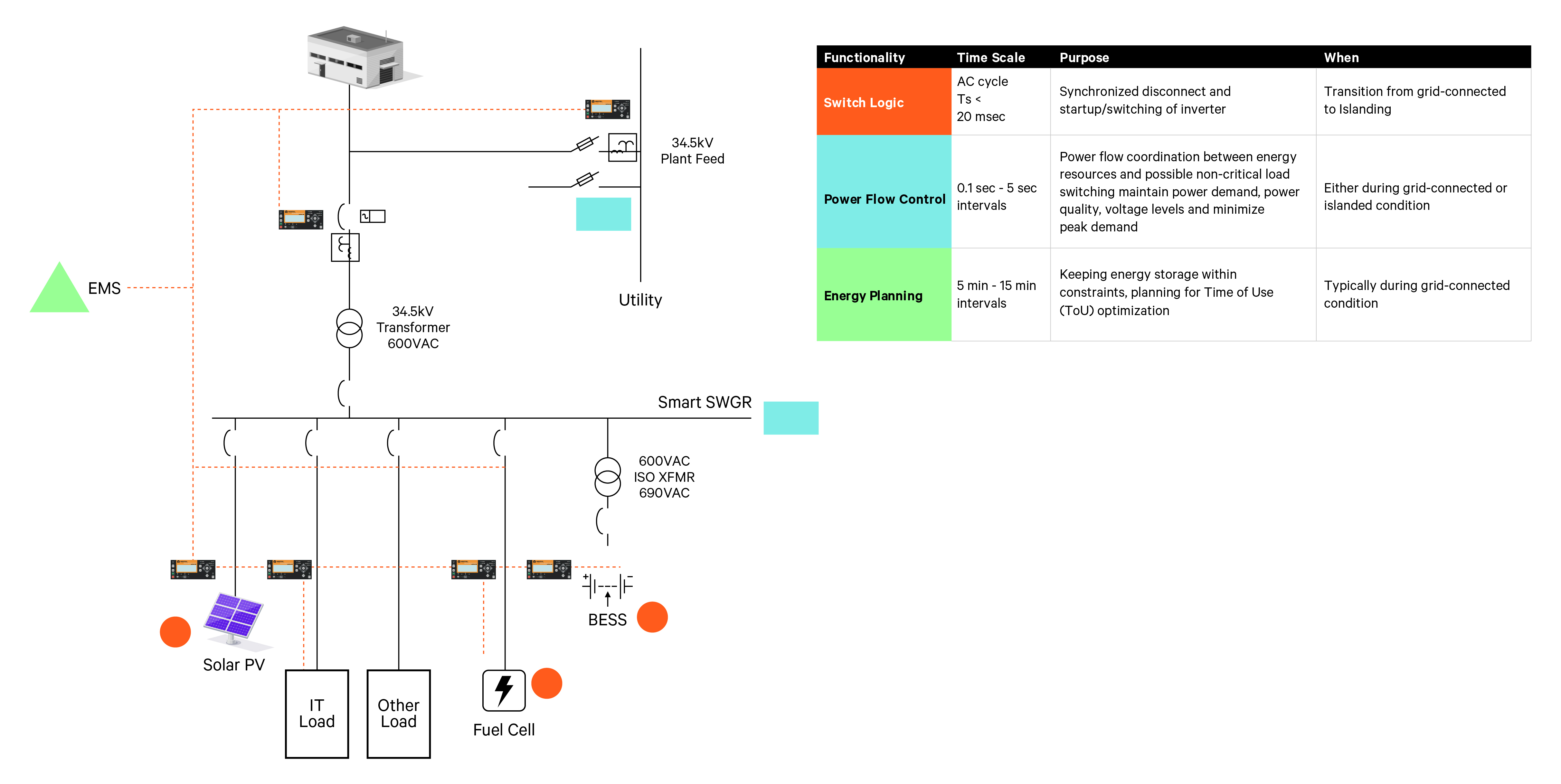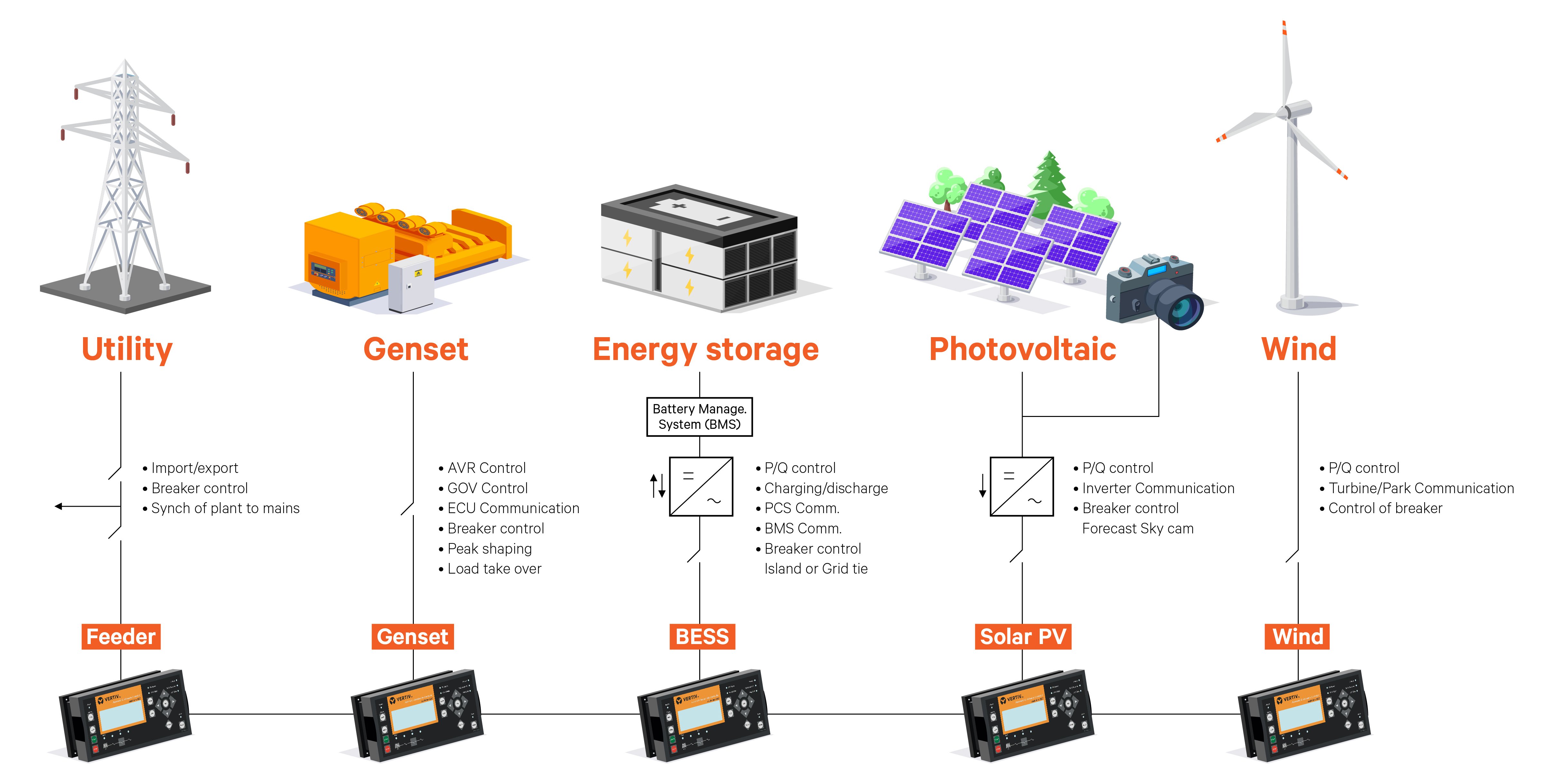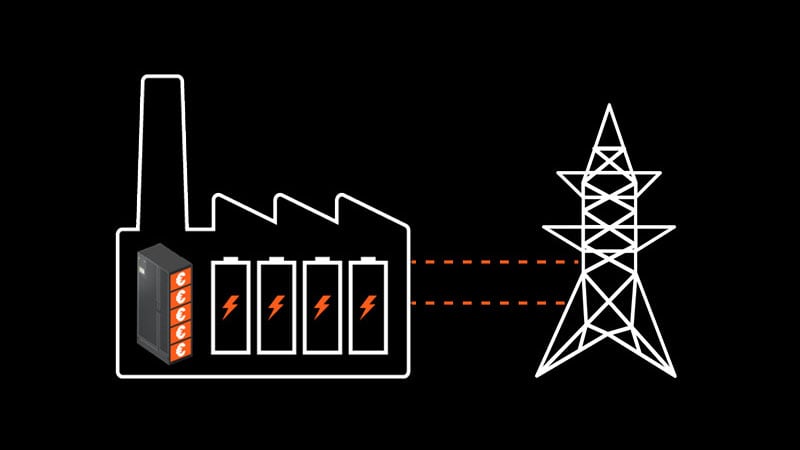Generally, a microgrid is a set of distributed energy systems (DES) operating dependently or independently of a larger utility grid, providing flexible local power to improve reliability while leveraging renewable energy. The system can be configured to prioritize renewables, such as solar, wind, and hydrogen fuel cells, switching to fossil power only when the situation requires it, making the technology more cost-effective. Excess electricity generated from renewable sources can be stored for use during periods of high demand, generally in battery energy storage systems (BESS) utilizing lithium-ion batteries. As the microgrid is independent, there is an immediate efficiency gain because utility transmission losses are avoided. Some utilities are even deploying microgrids as a solution to grid constraints helping to balance the load on the larger electrical grid and reduce strain on existing infrastructure.
Benefits of Utilizing Distributed Energy Resources
Microgrids employing distributed energy technologies offer a range of flexible benefits that traditional grid systems can’t match. They are more reliable, efficient, and flexible than their larger counterparts, providing clean energy sources with fewer emissions, and microgrid costs are generally lower due to using renewable energy sources. Central grids push electricity from power plants over long distances via transmission and distribution lines. Delivering power over significant distances is inefficient because some electricity – as much as 8 to 15% - dissipates in transit.
Additionally, microgrids provide an essential backup power source in case of outages or natural disasters and enable greater control over local energy production. A microgrid can disconnect from the central grid and operate independently. This “islanding” capability allows them to generate power and ensure reliability when a storm or other event causes an outage on the power grid.
One of the most critical distinctions in distributed generation is the operational resiliency inherent in the fail-safe islanding of mission-critical emergency power, which provides reliable power backup services during grid outages. The backup power provided by distributed energy resources which are “always-on,” ensures availability when critical load support is needed. Hybrid systems utilize continuous duty energy storage (such as a battery energy storage system) and distributed energy resources, including renewable energy, to have immediately available power and are "always on" in contrast to a stranded asset, such as a diesel generator. Gensets are not a backup power source that is in continuous operation. They need to be powered on. There is a possibility that during an outage, the generator may fail, bringing the mission-critical facility down. There is no switching on with "always on" power; it is always available.
Distributed Energy Technologies for Controlling Energy Costs
Fundamental to the autonomous operation of a resilient and possibly seamless DES is the unified concept of an automated microgrid management system, often called the “microgrid controls.” The control system can manage the energy supply in many ways. An advanced controller can track real-time changes in power prices on the central grid. (Wholesale electricity prices fluctuate constantly based on electricity supply and demand.) If energy prices are low, the controller may switch to buying power from the central grid rather than using energy from an owned energy source, such as solar panels. If this is the case, the microgrid’s solar panels will instead switch to battery storage (energy storage system). If prices rise, the microgrid controller may switch to discharging its batteries (or other distributed energy resources (DERs) rather than source power from the utility grid. This is known as peak shaving.

A microgrid with buses for critical load and (switchable) non-critical load, distributed energy resources (DERs), and consisting of photovoltaic, energy storage, and a fuel cell. (Similar to Vertiv’s microgrid at the Customer Experience Center in Delaware, OH)
The microgrid controller consists of three parts operating at different time scales and focusing on switch logic (red), power flow control (blue), and energy planning (green).
Important elements that decide the required capabilities of the microgrid controller include:
- The ability to integrate existing and new energy resources as the DES expands.
- The ability to provide services to manage utility costs (ToU (time of use) costs and peak demand tariffs).
- The ability to be reconfigured for contingency events and guarantee continuity of critical loads.
- The ability to seamlessly island in case of LoU (loss of use) of utilities or on demand.
- The ability to adapt the planning for daily energy demand (e.g. ToU costs) when energy storage capacity requirements change over time.
- The ability to allow for intervention by qualified personnel, despite autonomous operation.
- The ability to provide a history and communication of the system status of each DER.
- The inclusion of configurable cybersecurity requirements to protect the security of the microgrid.
Microgrid Feasibility Study
When considering building a microgrid for their mission-critical facility, operators should assess their current facility and power needs. First, the current grid-connected electrical power system infrastructure should be reviewed, including existing generation sources and available utility incoming sources. Power flow, any harmonic issues, power quality, and transient response issues should be noted, as well as issues with system restoration. A plant site visual audit of electrical equipment types, ratings, and operating conditions should be created. The microgrid configuration should be identified, including point(s) of interconnection with the utility grid and existing and future distributed energy resources (DERs) such as solar, wind, combined heat and power (CHP), fuel cells, and energy storage. A microgrid conceptual design should be created, including preliminary sizing and citing of distributed energy resources, preliminary electrical one-lines, and control system architecture, including desired modes of operation and switching sequences. Different scenarios should be considered regarding short- and long-term microgrid system configurations, including critical load uptime and black-start/extended outage capabilities ranging from one hour to one week.
Microgrids integrate existing and new energy resources, reduce energy costs, provide seamless islanding capabilities in case of power outages or natural disasters, and guarantee the continuity of critical loads. Introducing more resiliency into the mission-critical facility power system while allowing operators to generate electricity using prioritized energy sources, reduce the use of fossil fuels, and control their energy systems' cost, reliability, and flexibility make microgrids attractive. However, there are many considerations in designing and implementing a resilient and scalable microgrid. A partner with the experience to work with you from concept and design to installation, commissioning, and servicing throughout the site’s life is essential.
For more information on Microgrids, view our White Paper
Vertiv EMS System:
This control system is an energy management system that Vertiv uses globally for demand response, on-off grid, and grid services. The system connects to customer software which is an optimization layer. 





